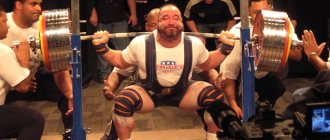In this material we will talk about a very important aspect of training, namely the question: how often do you need to change and adjust the training plan. A huge number of people who start training in the gym or fitness in general note that at the beginning of training, namely the first 1.5-2 months, the body reacts quite actively to the load, and then this effect disappears and often there is a feeling that not only nothing happens to the condition of the body, but even such indicators as endurance and strength also remain at the same level.
And one of the main mistakes of both beginners and many experienced trainees is the lack of changing the training program. People can do the same thing in the same order for years, and then say that the training “doesn’t work” and doesn’t bring any effect.
The basis of all this is such a concept as periodization of loads. And first of all, it is necessary to understand the theoretical component of this term.
How often should muscles be shocked?
You may have heard the conversations of old-school gym goers. They are all about “keeping the muscles ignorant” and “the frequency of shocking the muscles.”
In their opinion, you should regularly change your program so that muscle growth does not stop.
Well, to some extent they are right. You need to change your workouts to maintain progress.
But not because of muscular surprise. This is a myth that needs to end.
To some extent, adding variety to your workouts and using some tricks in your exercises is a fairly universal approach to training. But changing the load, number of repetitions and rest time are also important.
In this article, we will look at how often you should change your bodybuilding training programs...
When to change your training program
The most obvious criteria that it is really time to “adjust” the training plan are the following:
1) lack of result - if the muscles “do not respond” to the load, the proportions of the body do not change and this happens over a fairly long period of time (of course, subject to regular training and a diet that meets the goal)
2) training has become boring - this is a very important criterion, which, in my opinion, is a compelling argument in favor of changing the training plan. After all, if classes have ceased to be enjoyable, then there is a huge chance that soon you will simply “give up” on training.
3) changing the goal - if you previously worked, for example, to increase muscle mass, and then decided to develop endurance with the help of aerobic exercises, then doing this within the same training plan is, frankly speaking, a “difficult task”
4) change in daily routine - we do not always have the opportunity to significantly influence our schedule, and accordingly, the training regime needs to be adjusted to our time capabilities. Someone is forced to train twice a week for two hours, while others can do it every day, but no more than half an hour. This means that the training plan will look different.
Muscle Building Basics
Regular readers are most likely already familiar with the basics of building muscle mass.
But even the owners of a couple of 50-centimeter biceps and quadriceps on which ordinary pants are cracking can always learn something new.
The bottom line is that nonsense like “shock your body” is just a myth. Muscles have no brain and cannot think for themselves.
You can't walk up to a squat rack, set up for a squat, and then suddenly do a set of dumbbell curls and think you've somehow tricked your arms into growing them faster.
This is simply absurd.
As long as the stimulus is greater than usual, you will continue to gain weight. Forget about gimmicks, nonsense, and tricks like “shocking the muscles.”
But how exactly do you keep the stimulus at the forefront?
Here are the basic principles of gaining muscle mass...
Progressive overload
When you increase the load and lift heavy weights or perform a high-rep set to failure, your body takes you on a journey where it has never been before.
Progressive supercharging for the body means challenging it with something unusual.
Your body is an amazingly smart thing.
When it is challenged on a consistent basis, it adapts. By doing cardio, you develop higher aerobic endurance, and by playing competitive sports, you become more agile.
And if you lift damn heavy weights, your body adjusts, building muscle and getting ripped.
If you use the same weights every workout, your body will eventually not receive enough stimulus to grow muscle.
After some time, your muscle mass will stop increasing altogether.
Just a tip: You need to follow the principle of progressive overload to build muscle.
Sufficient volume
Stimulating muscle growth requires more than just being pumped up or taking a shit ton of tracksuit selfies.
To really build muscle you will need a sufficient amount of exercise.
By volume we mean the total load, which is obtained by multiplying the working weights by the number of approaches and repetitions.
For example:
100 kg bench press with 3*12 reps will give a “load volume” of 3,600 kg.
The greater the volume of the load, the more mass you gain. It doesn't matter by increasing the number of repetitions or using heavier weights.
Just a hint: The higher the load volume, the more growth you will get.
How quickly does adaptation occur?
The human body is a unique organism that can adapt to all life changes. In order for the brain to get used to something new, it only needs three weeks. And after this time, the action repeated day after day becomes a regular habit.
A few trainings are enough for the muscles to begin to adapt to new loads. Habits can be considered using a simple example: when, after the first exercise, muscles ache, and after a while, the same loads no longer have a negative effect. Experienced athletes know how to feel their body, and they are very good at using pumping and other interesting things.
Time it takes to get used to the training:
- Beginner athletes, their addiction occurs up to sixteen weeks;
- For those who can be called semi-experienced, their bodies become habituated in about eleven weeks;
- Experienced athletes take up to six weeks to get used to it.
When should you make changes to your bodybuilding training program?
The bottom line is that you should only change your workout when it no longer feels unusual.
Although the reasons for changing the program can vary, here are the most common ones:
- You don't get stronger, leaner, or gain quality muscle gains;
- You feel tired during the current program;
- Significant loss of energy and overall motivation, in a word, you are bored;
- Your goals have changed and you suddenly decide to run a marathon or do some other crazy thing instead of bodybuilding;
- When changing the phase of training - gaining strength, muscle mass, working on relief - require different schemes and approaches.
Why change your bodybuilding and fitness workouts?
It should be recognized that it is necessary to change your training program. Thanks to this you will be able to get the following results:
- Accelerate progress in working weights.
- Rapid gain of muscle mass.
- Accelerate the growth of physical parameters.
- Get rid of excess weight faster.
Muscles are not ordinary threads, but quickly adapting and learning fibers that can contract.
In order for the body to activate muscle growth processes, it is necessary to put them in uncomfortable conditions that they have never encountered before. It is the factor of muscle fiber overload that is the main principle of strength training. Only in this situation will you be able to gain weight. As soon as you increase the working weight, or introduce a new movement into the training program, the muscles are subjected to severe stress. As a result, the athlete is actively gaining weight, and his physical parameters are growing. The duration of this period of time is a maximum of one month. As soon as the body adapts to previous changes. The rate of progress of the builder begins to decline and as a result a plateau may occur.
It must be said here that changes made to the training program should not be limited only to increasing working weight. Joe Weider introduced various principles of increasing intensity into bodybuilding, such as supersets. In addition, it is worth changing such parameters as the number of sets and repetitions in them.
The Best Ways to Change Up Your Bodybuilding Workout
So your progress has stopped, you're tired of your current program, or your goals have changed.
How exactly can you change your training program?
Well, depending on the situation.
But here are a few ways to get back on track and resume muscle growth...
Use an advanced training system
When it comes to muscle-building training systems, there are a plethora of options available.
You can dive into cluster sets (rest-pause principle), or even run up to something like isometric exercises that will make you cry when you extend your legs.
You don't even change your training routine - you just add a little special sauce to the exercises you already use.
Don't Rely on Muscle Split
Old school bodybuilders love a good split. Chest on Monday, delts on Wednesday - something like that.
But if you decide to work only one muscle group per workout, you'll soon be left without ideas for specific exercises. You've been doing bent over rows and lat pull-downs for months and you just can't think of other ways to work these muscles.
But full-body workouts not only build more muscle, they also give you more training options. Mainly because you don't have to do as many workouts during the week.
Use repeat loops
Using the period technique, where you change the focus of your training every 4-6 weeks or so, allows you to schedule rep ranges and loads often enough to continue muscle growth.
Rep cycling is a great way to increase progressive overload while still getting the volume of muscle-split work done in the program.
You can perform one month of sets of 4-6 reps with heavy weights, and then for the next month do lighter, high-rep sets of 12-120. You don't even have to adapt your exercises depending on the option you choose.
Replacing exercises
It's not that important to change the exercises you use.
As you can see from the above, there are many productive ways to maintain muscle growth before you need to review your training program and make changes to it.
But choosing exercises can be used as a way to keep things fresh and interesting.
In the periodization of training, several cycles are usually distinguished:
Macrocycle - most often it represents the time required to achieve the final goal, i.e. a specific “intended” state of the body and lasts, as a rule, from six months to a year (but the time period will be individual for everyone). For professional athletes, this period usually coincides with the period of preparation for certain competitions.
A mesocycle is a component of a macrocycle dedicated to achieving one intermediate goal, for example, gaining muscle mass, increasing strength, or reducing the percentage of one of the three types of fat in the body and achieving muscle definition. Most often, such cycles last 2-3 months.
A microcycle is a period of the mesocycle, which also pursues its own specific motives. Typically, the entire microcycle is one training week, during which a different number of training sessions, or, in other words, training sessions, may be expected. During the microcycle, the intensity of training may change, i.e. the amount of weight, the volume of training, which can be measured in the number of approaches or total tonnage, new exercises appear, etc. All this relates to microcycle planning.
The concept of load periodization initially appeared in the training tactics of weightlifters, and only later appeared in bodybuilding and powerlifting. Later the concept spread to fitness. That is why most often they talk about periodization in the context of these sports and, accordingly, mention the goals characteristic of them. But you need to understand that periodization exists in any sport, only its principles will be very different, because different sports areas require the development of different characteristics. So, for example, a marathon runner absolutely does not need to worry about growing muscle mass; his main goal is endurance.
Most likely, most of those who are reading this text now have the same question: “Why do I need to know this?” I fully understand that my audience is not competitive athletes or professional powerlifters. These are people who engage in fitness to maintain health or shape their figure. That is why I will not go into a description of different approaches to periodization of loads. But even if you do fitness “for yourself” and not for the podium, I’m sure you also want to see constant progress and visual results from your classes. That is why you need to “periodize” your training plan.
What might this look like in practice? Let's look at an example and take the most common case. Let's say there is a girl who is 10 kg overweight. She has never been involved in sports or fitness, physical activity is quite difficult for her, but after 6 months she really wants not only to get rid of extra pounds, but also to “acquire” some “shapes” in the buttocks area.
Then it turns out that 6 months is a macrocycle. I would divide this period into 3 mesocycles:
1st - an adaptation period, during which all body systems will adapt to constant loads, and the technique of performing basic exercises will be studied (as a rule, 1 month, a maximum of 1.5 times, will be enough);
2nd - it is better to devote this time to high-quality “working” of muscles against the background of moderate nutrition (2-2.5 months);
3rd - direct reduction in the percentage of body fat and final correction of proportions (respectively, the remaining 2-3 months).
Well, it is clear that a separate training week within each mesocycle will serve as a microcycle.
Immediately anticipating criticism, I want to clarify that the above scheme is simply one of the most common options for solving such a problem and, by no means, the only one. There can be quite a lot of ways to achieve a similar goal, as well as types of training.
Why do you need to know this? In order to understand that it is impossible to achieve everything at once. And if, for example, you have never played sports, come to a trainer and say that in two months you need to go on vacation and by this time you urgently need to lose 15 kg, pump up your “super butt” and it is also advisable to learn how to run 20 km without stopping - this is unlikely. All these are separate stages that require some time for their implementation.
But it is the division of the training plan into intermediate goals that will allow you to reach the final result and, accordingly, avoid the so-called training plateau, during which the body adapts to the type and order of exercises and stops responding to them.
When a fitness routine becomes irrelevant after just a month
For both experienced athletes and beginners, four weeks is usually enough to determine how effective the training regimen they are using is. The absence of positive changes during this period may mean the failure of the training plan, which means that it needs to be mercilessly redrawn.
In some cases, a couple of weeks are enough to evaluate a new fitness program , but no less. Additionally, you should consider whether other factors, such as insufficient rest or poor nutrition, are inhibiting development.
Is it possible to do fitness according to the same program for more than two months?
It also happens that an athlete uses an exercise regimen for a long time with stable health benefits. In this case, you should not change your training plan on principle, but you should remember that such an effect rarely lasts longer than four months. If you don't modify your gym program, your effectiveness will inevitably decrease - that's a fact you can't argue with. Professional trainers and the best sports doctors agree that not a single gym visitor can exercise according to an unchanged program without deteriorating results.
The myth of muscle confusion
Your muscles don't get confused, don't get emotional, can't be shocked. Muscles don't "think", they contract, shortening and lengthening when forced and adapting, strengthening in response to the increasing levels of stress they are subjected to. They don't know or care what exercises or workouts you use. All they know is tension. It is true that muscles will eventually adapt to the training stimulus and stop growing. This is a proven fact. But that doesn't mean you need to change your workout routine. In order for them to continue to grow, they need to increase the training stimulus, not change it. This is called progressive loading and is really the only thing you need to change.
Building muscle is about manipulating the body's adaptive response. Muscles adapt in response to how much tension they experience. For example, if you can bench press 250 pounds for 10 reps, over time your muscles will adapt to the stress and become larger and stronger to handle the load. This is how all muscles work. Now, once the muscles have adjusted to 100kg for 10 reps, they stop growing. Your muscles have done their job and are now able to handle the load easily. To continue to grow, you must add more weight to the bar. Increase the weight to 105 kg in your next workout and you will create a new stimulus to increase tension in the muscles. If you are following a good training program and performing exercises with good form and activation of the target muscle, then there is really no need to change anything.
Most people:
- Train each muscle once a week at high volume (more sets)
- Train each muscle twice a week at low volume (fewer sets)
Any of these training methods are effective in increasing muscle growth for years as long as you increase the load on the muscle by adding more weight over time. The key to getting bigger and stronger is consistency. This means following an effective workout program consistently, week after week, month after month. The change in training routine and training days is not consistent. You cannot progress and improve if you keep changing procedures. If you keep jumping from one workout to another and constantly changing exercises, you will never see good consistent results. It's good to alternate a few different exercises each week (as shown below), but you don't need to change your entire program.
Week 1: Monday (chest): bench press
Week 2: Monday (chest): dumbbell bench press
As has been said many times, building muscle is not about moving weights, but using the weight as a tool to apply load to the movement that the muscle creates. Muscles need consistent progressive loading, not confusion. Keep growth stimulating by increasing tension. Like many myths in bodybuilding, they have been created by supplement companies or magazines with a financial interest. Truth doesn't sell bodybuilding magazines. They need to keep releasing shiny new "Better Than Last Month" workout programs every month to keep making sales. There are no bodybuilding magazines that will give you an effective workout program and have you follow it for the next three years. Of course, they will give you 6, 8 or 12 week mass training workouts to keep you coming back for more!
Levels of training
Experts advise remembering that training changes occur based on the level of preparedness:
- Beginners. The program is changed at 10-16 weeks, or after 2.5-4.5 months.
- Average level. Optimal period: 8-11 weeks, or 2-3 months.
- Advanced. The change occurs at 4-6 weeks, or after a month and a half.
Thus, before starting the transition to a new program, it is worth understanding the level of preparation. If training began not so long ago, the body is not yet ready to change the program, and changing the program too quickly can cause harm.
Main aspects
At first, a person’s muscles actively react to the load, but over time they get used to it. If at first they experienced stress from the load and there was progress in the training process, then it gradually subsides. If you don’t change the program, there will be no sense at all, and the training itself will turn into a routine.
According to experts, most often at 9-12 weeks the muscles get used to the loads, innovations are required. But such indicators are suitable for those who regularly play sports, whose muscles are able to withstand heavy loads. For beginners, the change in training should occur 5 or even 10 weeks later than for professionals.











